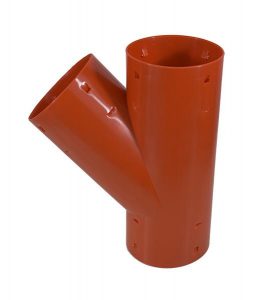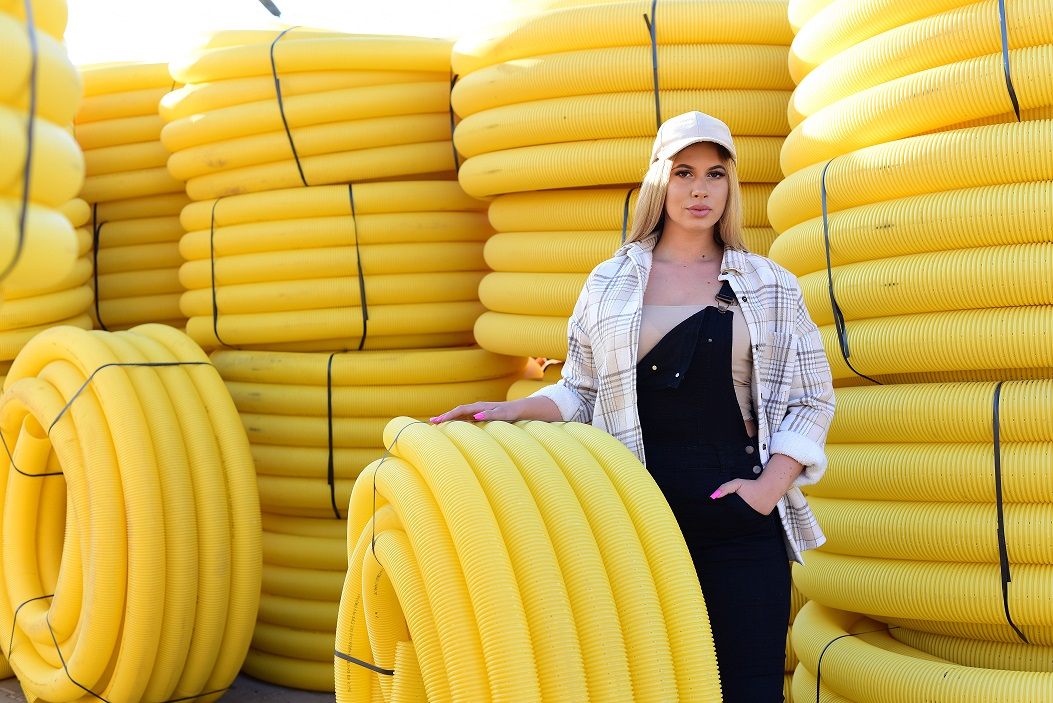Głównym zastosowaniem układów drenarskich jest odwodnienie gruntu. Jednak coraz częściej w połączeniu z układami rynnowymi używa się ich do rozsączania wody deszczowej. System drenażowy, który tworzy taką instalację jest trwały, lekki i prosty w montażu.
Drenaż – funkcja i przeznaczenie
Drenaż jest systemem odwadniającym grunt. Ma on na celu zbieranie zalegającej w gruncie wody i odprowadzanie jej w miejsce, gdzie można ją bezpiecznie oddać, np. do kanalizacji, rowu melioracyjnego lub zbiornika na wodę deszczową. Układy takie stosuje się w celu zabezpieczenia terenu przed wysokim stanem wód gruntowych, lub wodami opadowymi zalegającymi po na nieprzepuszczalnym gruncie gliniastym lub iłowym. Dzięki działaniu takiego układu grunt jest stabilny, nie przemaka i nie jest podmywany. Ponadto pozwala on chronić stabilność terenu w pobliżu fundamentów budynków.
Z rur i kształtek drenarskich można również łatwo wykonać skuteczny układ rozsączający wodę deszczową do gruntu.
W połączeniu z układem rynnowym budynku jest to prosty i skuteczny sposób odprowadzania wód deszczowych z dachów, który jest przyjazny dla środowiska i bezpieczny dla gruntu i fundamentów budynku.
System drenażowy tworzą głównie rury
Rura drenarska bez otworów
Ten typ rury jest używany w układach drenarskich na odcinkach na których rurociąg nie zbiera, ani nie rozsącza wody. Jest to rura pełna, która służy do budowy odcinków instalacji takich jak odprowadzające zebraną wodę od fundamentów budynku.
Rura drenarska z otworami
Jest to podstawowy typ rury drenarskiej. Jest to rura karbowana jednowarstwowa z otworami na całym obwodzie rury. Służy ona do budowy czynnego odcinka drenażu, a dzięki wyciętym otworom pozwala zarówno na zbieranie wody z podmokłego gruntu, jak i na rozsączanie wody deszczowej odprowadzonej z rynien budynku.
Rura drenarska w otulinie z geowłókniny
Jest to rura drenarska z dodatkową otuliną filtrującą nawiniętą na zewnętrzną warstwę rury. Pełni ona w układzie tą samą funkcję co rura drenarska bez otuliny, aczkolwiek dzięki otulinie może być używana trudniejszych warunkach gruntowych. Otulina z geowłókniny ma za zadanie zatrzymywać drobne frakcje gruntu na zewnątrz rury, dzięki czemu zapobiega zamuleniu układu drenarskiego.
Rura drenarska w otulinie PP 700
To rura drenarska z grubszą i gęstszą otuliną na zewnątrz rury. Jest to produkt przeznaczony do stosowania w szczególnie trudnych warunkach glebowych, na przykład w gruntach gliniastych.

Rys. 1: Rura drenarska PVC 100 z otuliną z geowłókniny – zwój 50 m
Kształtki drenarskie – łączą system drenażowy
- Mufa drenarska – służy do połączenia ze sobą dwóch odcinków rury drenarskiej o takiej samej średnicy.
- Złączki drenarskie – służą do łączenia rur drenarskich z rurami lub kształtkami innych systemów, na przykład z rurami kanalizacyjnymi.
- Kolano drenarskie – służy do połączenia dwóch odcinków rury drenarskiej o tej samej średnicy pod kątem, co pozwala wykonać zakręt rurociągu.
- Trójnik i czwórnik drenarski – służy do wykonywania rozgałęzień układu drenarskiego. Trójniki drenarskie mogą być również trójnikami redukcyjnymi, pozwalającymi na łączenie rur o różnych średnicach. Trójniki posiadają trzy gniazda do połączenia z rurą drenarską, a czwórniki mają cztery.
- Zaślepka drenarska – służy do zamknięcia zakończenia rury drenarskiej. Zaślepka jest pełna i nie ma otworów.
- Redukcja drenarska – redukcja drenarska służy do połączenia dwóch odcinków rury drenarskiej o różnych średnicach.
- Zakończenie drenarskie – służy do zabezpieczenia odkrytego zakończenia rury drenarskiej. Jeśli rura drenarska odprowadza zebraną wodę na przykład do rowu, zakończenie drenarskie wzmacnia jej wylot i zabezpiecza go przed zgnieceniem. Dzięki wbudowanej kratce zakończenie również zabezpiecza układ drenarski przed wejściem gryzoni.
Wszystkie kształtki drenarskie łączą się z rurą przez specjalne zatrzaski łapiące za karby rury i zapobiegające się wysunięciu.
Dodatkowe akcesoria do budowy układów drenarskich
Układy drenarskie składają się nie tylko z rur i kształtek. Przydatne mogą okazać się również studzienki, czy dodatkowe materiały wykończeniowe.
Geowłóknina
Geowłóknina dostępna jest w rolkach o różnej szerokości. Jest to materiał niezwykle przydatny przy układaniu układu drenarskiego. Można użyć go do owinięcia samej rury drenarskiej, a także do wykonania warstw filtracyjnych wokół obsypki.
Studzienki
W układach drenarskich studzienki mogą spełniać różne funkcje, np. rewizyjną, rozsączającą, osadnikową. Studzienki mogą być artykułami gotowymi lub złożonymi z rur trzonowych karbowanych, pokryw do nich i innych artykułów pomocniczych, takich jak na przykład uszczelki in-situ, pozwalające na wprowadzenie rury drenarskiej do wnętrza studzienki.
Osadniki podrynnowe
Wykorzystuje się je w układach rozsączających. Służą jako przejście z umieszczonego na budynku układu rynnowego na podziemnym rurociągiem rozsączającym. Ze względu na kierunek odprowadzenia wody deszczowej z osadnika rozróżniamy osadniki dolne i osadniki boczne.

Rys. 2: Trójnik drenarski DN 100/100/45 PP pomarańczowy
Korzystając z powyższych produktów można budować kompletne układy drenarskie i rozsączające wodę deszczową do gruntu. Większość elementów układu montowana jest na wcisk i nie wymaga dodatkowych uszczelnień ani specjalistycznych narzędzi. Układy te nie tylko pozwalają zabezpieczyć i stabilizować grunt, ale ich zastosowanie jest również ekologicznie uzasadnione, ponieważ pomagają zachować poprawny obieg wody w przyrodzie nawet na terenach utwardzonych.
